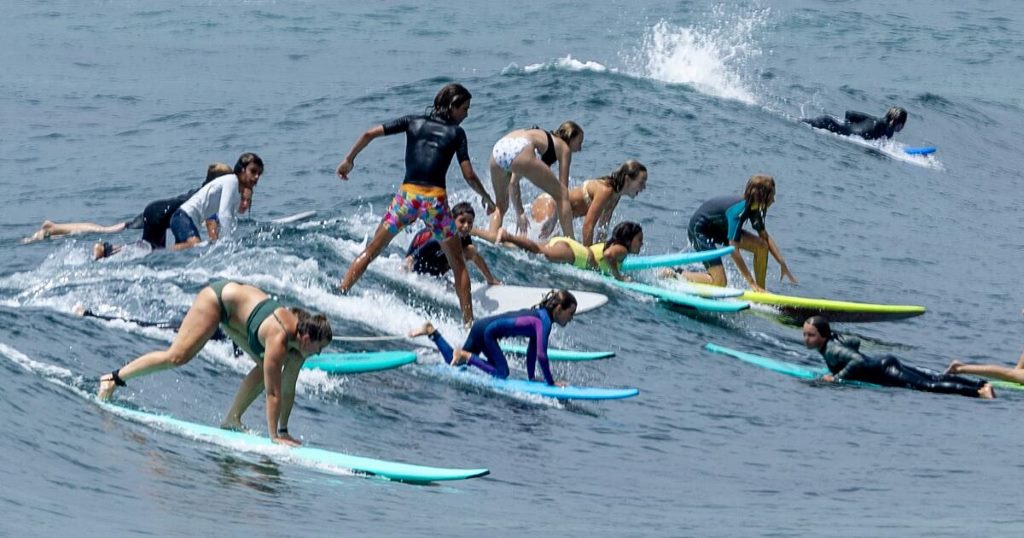
Surfing Safety Tips for Crowded Lineups
The ocean hums with energy, waves crashing in a rhythm that calls surfers to the lineup. Yet, in crowded breaks, the thrill of catching a wave can turn chaotic. Surfing safety tips for crowded lineups become vital to ensure everyone enjoys the ride without collisions or conflicts. As a surfer who’s navigated packed New York breaks, I’ve learned the hard way how respect and awareness keep the vibe positive. Whether you’re a beginner or a seasoned rider, understanding lineup etiquette is key. To dive deeper into local surf culture, explore New York Big Event to know what’s happening at the coast. This guide shares practical tips, backed by research and personal experience, to help you surf safely in busy waters.
Understanding the Crowded Lineup
Crowded lineups are common at popular surf spots, especially in urban hubs like New York. With more surfers hitting the waves, the risk of accidents rises. According to a 2019 study by the International Surfing Association, 60% of surfing injuries occur in crowded conditions due to collisions or board mishaps. The lineup is where surfers wait for waves, and in busy spots, it’s a mix of skill levels and egos. Tensions can flare when rules aren’t followed.
My first time surfing in New York City at Rockaway Beach taught me this. The lineup was packed, and I nearly collided with a longboarder who didn’t signal his drop-in. Clear communication and respect for priority could’ve prevented the scare. Knowing the unwritten rules, like who has the right of way, helps maintain harmony and safety.
Prioritizing Right of Way
In a crowded lineup, right-of-way rules are non-negotiable. The surfer closest to the wave’s peak or breaking point has priority. Dropping in on someone else’s wave is not only rude but dangerous. A 2021 report from Surfing Medicine International noted that 45% of lineup injuries stem from drop-ins causing collisions. To avoid this, always look before paddling for a wave.
Additionally, respect local hierarchy. Regulars often know the break best and expect newcomers to follow suit. When I started surfing in NYC, I watched locals to learn the pecking order. If you’re unsure, wait for a wave others pass on. Communicate clearly—call out if you’re going left or right. This reduces confusion and keeps the lineup flowing smoothly.
Communicating Effectively with Fellow Surfers
Clear communication is a lifeline in crowded breaks. Shouting “going left!” or “my wave!” signals your intentions, reducing the chance of collisions. Hand gestures also work, especially in noisy conditions. According to a 2020 study by the Journal of Coastal Research, 70% of surfers rely on verbal or visual cues to navigate busy lineups safely. Miscommunication often leads to accidents, so clarity is crucial.
Once, at Long Beach, I misjudged a wave and nearly cut off another surfer. A quick shout of apology and a wave diffused the tension. Always acknowledge mistakes—it builds trust. If you’re new to a spot, ask locals about common signals. This small effort fosters respect and keeps the lineup safer for everyone. Follow Five Reasons Why You Should Watch Sports.
Maintaining Personal Space and Awareness

Crowded lineups demand spatial awareness. Boards can become hazards if surfers paddle too close. Keep at least one board length between you and others to avoid entanglements. The National Surf Schools and Instructors Association recommends a 10-foot buffer zone in busy conditions to minimize risks. Scanning your surroundings before paddling or standing up prevents crashes.
I learned this lesson at Montauk, where a crowded summer session left little room to maneuver. By staying alert and keeping distance, I avoided a tangle of leashes. Additionally, watch for rogue boards or wipeouts. If someone falls, paddle wide to avoid their board. Staying mindful of your position ensures you’re not the cause of chaos.
Choosing the Right Equipment for Safety
Your gear can make or break safety in a crowded lineup. Soft-top boards are ideal for beginners, reducing injury risk during collisions. For advanced surfers, a leash is non-negotiable—it keeps your board from becoming a projectile. A 2022 study by the Surfing Medicine International found that 30% of lineup injuries involve loose boards. Ensure your leash is in good condition and matches your board size.
Moreover, wear a wetsuit with adequate padding in colder climates like New York. During a chilly session at Rockaway, my wetsuit cushioned a minor board hit. Also, consider a helmet for rocky breaks. Choosing equipment suited to the conditions and crowd level protects you and others in the lineup. Discover Fine-Tuning Your Technique for Specific Surfboard Tricks.
Practicing Etiquette to Avoid Conflicts
Surfing etiquette is the glue that holds crowded lineups together. Don’t snake waves by paddling around someone to steal priority—it’s a surefire way to spark conflict. Respect the lineup’s flow and wait your turn. The Surfrider Foundation emphasizes that good etiquette reduces confrontations by 80% in busy breaks. Apologize if you mess up, and don’t hog waves.
My first crowded session in New York taught me patience. I waited for my turn, watched the rhythm, and earned respect from locals. If tensions rise, stay calm and talk it out. A smile or quick apology often diffuses disputes. Good manners not only keep you safe but also make the lineup a better place for everyone.
Preparing for Emergency Situations
Crowded lineups can amplify emergencies. Know basic first aid, like treating cuts or recognizing concussion signs, as injuries are common. The American Red Cross reports that 25% of surfing injuries require immediate attention, often from board impacts. Carry a small first-aid kit in your bag for minor scrapes. If someone’s hurt, signal for help and clear the area.
I once saw a surfer at Ditch Plains get hit by a board. Quick action from nearby surfers got him to shore safely. Learn the beach’s emergency protocols, like lifeguard signals or nearest medical facilities. For more on local safety resources, check Surfrider Foundation or NOAA’s coastal safety page. Preparation can save lives in chaotic lineups.
Timing Your Session to Avoid Peak Crowds
Timing can ease the stress of crowded lineups. Dawn or late afternoon sessions often have fewer surfers, as most hit the beach mid-morning. Surfing Medicine International data shows that 65% of crowded lineup incidents occur between 10 a.m. and 2 p.m. Check tide charts and surf reports to plan around quieter times. Apps like Surfline offer real-time crowd updates.
I’ve found early mornings at Rockaway less hectic, letting me focus on waves, not dodging boards. If you must surf peak hours, stick to less popular breaks nearby. Timing your session strategically reduces risks and makes surfing more enjoyable. Always check local conditions before heading out.
Building Skills to Navigate Crowds
Strong surfing skills boost safety in crowded lineups. Practice quick turns and controlled wipeouts to avoid others. The International Surfing Association suggests beginners take lessons to master board control, reducing accidents by 50%. Confidence in your abilities lets you react swiftly in tight situations. Take time to improve paddling strength for better positioning.
During a packed session at Long Beach, my ability to pivot mid-wave saved me from a collision. Lessons at a local surf school helped me gain that control. For skill-building tips, visit Surfrider Foundation. Regular practice in less crowded conditions builds the confidence needed to handle busy breaks safely.
Conclusion
Navigating crowded lineups is a skill that blends respect, awareness, and preparation. By following surfing safety tips for crowded lineups, you can ride waves confidently while keeping the vibe positive. From respecting right of way to choosing the right gear, these practices protect you and others. My experiences surfing in New York taught me that patience and communication turn chaotic breaks into shared playgrounds. With 60% of surfing injuries linked to crowded conditions, per the International Surfing Association, these tips are more than advice—they’re essential. To learn more about local surf events, explore New York Big Event to know what’s happening. Share your lineup stories in the comments or pass this guide to fellow surfers to spread safety!
FAQs
How can I avoid collisions in a crowded lineup?
Stay aware of your surroundings, maintain a 10-foot buffer, and communicate your intentions clearly with shouts or gestures to prevent accidents.
What’s the most important surfing etiquette rule?
Respect the right of way. The surfer closest to the wave’s peak has priority, and dropping in on their wave risks collisions and conflict.
Why is timing important for surfing crowded breaks?
Early morning or late afternoon sessions have fewer surfers, reducing risks. Most incidents occur mid-morning, per Surfing Medicine International.
What gear helps with safety in crowded lineups?
Use a leash to secure your board, wear a padded wetsuit, and consider soft-top boards or helmets for added protection in busy breaks.
How do I handle conflicts in the lineup?
Stay calm, apologize for mistakes, and communicate respectfully. Good etiquette, like waiting your turn, prevents most disputes.


Average Rating